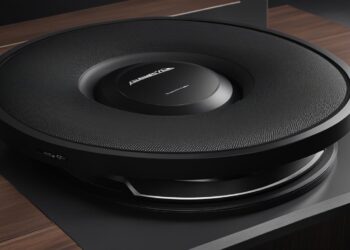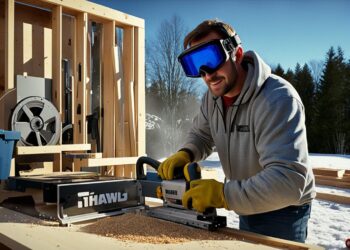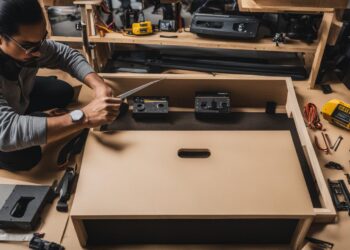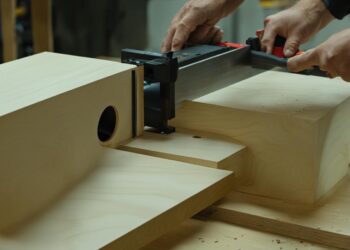Welcome to our DIY guide on how to build a box for a 15 inch subwoofer! Are you tired of the generic subwoofer boxes on the market that don’t quite meet your expectations? Are you ready to customize the look and fit of your subwoofer to match your unique style and needs? If so, you’ve come to the right place.
Building your own subwoofer box can be a rewarding and cost-effective project. With just a few basic tools and materials, you’ll be able to design and construct a box that not only looks great but also enhances the performance of your subwoofer.
But where do you start? How do you ensure the box is the perfect fit for your 15 inch subwoofer? And what are the key considerations when it comes to designing and building the box? Let’s dive into the step-by-step instructions and explore the world of DIY subwoofer box building.
Key Takeaways:
- Building your own subwoofer box allows you to customize the look and fit of your subwoofer.
- You can save costs by building your own subwoofer box instead of buying one.
- Designing the dimensions of your box is crucial for optimal performance.
- Choosing the right subwoofer and considering the different enclosure types are also important factors to consider.
- By following our step-by-step instructions, you’ll be able to create a custom subwoofer box that meets your specific needs.
Choosing the Right Subwoofer
When it comes to selecting a subwoofer for your box, there are a few important factors to consider. One of the most crucial considerations is the manufacturer’s recommended enclosure size. This recommendation ensures that the subwoofer performs optimally and fits within the available space.
The box volume plays a pivotal role in determining the size of your enclosure. If you have limited space in your vehicle, you may need to opt for a smaller subwoofer that requires a smaller box volume. It’s essential to take into account the manufacturer’s recommendations regarding enclosure size so that you can choose a subwoofer that not only fits your desired box size but also delivers the desired performance.
By carefully considering the recommended enclosure size and box volume, you can select a subwoofer that perfectly fits your requirements. This ensures optimal performance and eliminates any unnecessary guesswork or potential compatibility issues. Remember to prioritize both the size and performance of the subwoofer, as they are closely interconnected.
Planning Your Box Design
When it comes to designing a subwoofer box, careful planning is essential to ensure optimal performance. The dimensions of your box, including the depth, height, and width, need to be determined based on the size of your subwoofer and the available space in your vehicle.
Start by measuring the size of your subwoofer and the area in your vehicle where you plan to install the box. These measurements will serve as the foundation for your box design. Sketching out the design on paper can help visualize the final product and make adjustments as necessary.
It’s important to not only consider the external dimensions but also the internal dimensions of the box. Take into account the thickness of the wood used for construction to ensure accurate calculations. By calculating the internal box volume, you can make sure it aligns with the manufacturer’s recommended enclosure volume.
Adjustments may need to be made to match the desired volume as closely as possible. Factors such as the subwoofer’s specifications and your listening preferences can influence the final adjustments to optimize sound quality.
Determining the Internal Box Volume
To calculate the internal box volume, follow these steps:
- Measure the height, width, and depth of the internal space available for the subwoofer box.
- Multiply these dimensions together to determine the internal box volume in cubic inches.
- Convert the volume to the appropriate unit (e.g., cubic feet) if desired.
For example, if you have a space that is 12 inches high, 24 inches wide, and 18 inches deep, the internal box volume would be 12″ x 24″ x 18″ = 5,184 cubic inches (or approximately 3 cubic feet).
By carefully planning the dimensions of your subwoofer box and ensuring the internal box volume aligns with the manufacturer’s recommended enclosure volume, you can create an enclosure that maximizes the performance of your subwoofer.
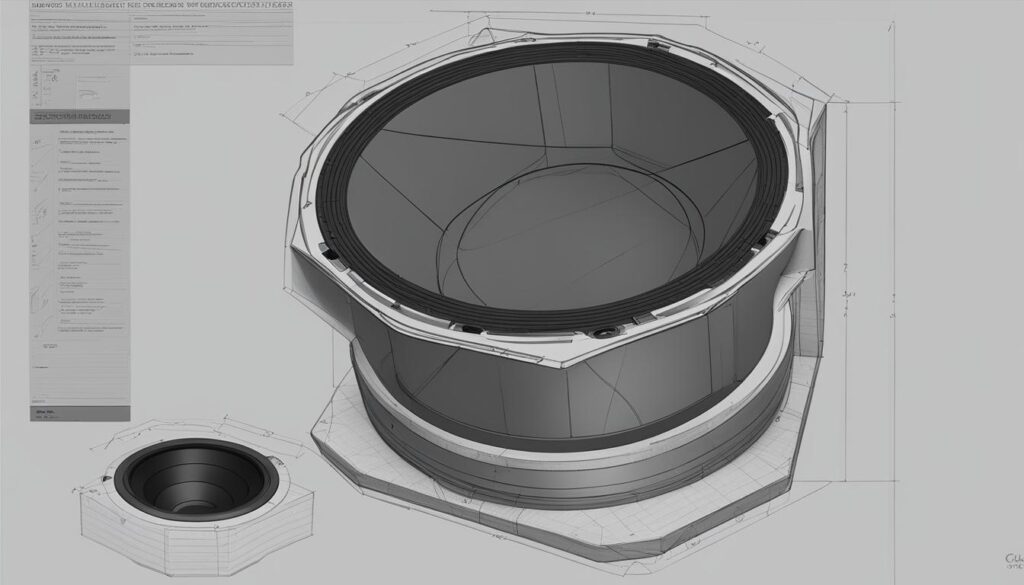
| Dimensions | Box Volume | ||
|---|---|---|---|
| Height: 12 inches | Width: 24 inches | Depth: 18 inches | 5,184 cubic inches (3 cubic feet) |
| Height: [Height] | Width: [Width] | Depth: [Depth] | [Box Volume] |
| Height: [Height] | Width: [Width] | Depth: [Depth] | [Box Volume] |
| Height: [Height] | Width: [Width] | Depth: [Depth] | [Box Volume] |
Table: Examples of Box Dimensions and Volume
Step-by-Step Instructions for Building the Box
Building a subwoofer box is an exciting DIY project that allows you to create a custom enclosure for your subwoofer. In this section, I will guide you through the step-by-step process of building your own box, ensuring you have all the necessary tools and materials for a successful construction.
Tools and Materials
Before we begin, let’s gather all the tools and materials required for building your subwoofer box:
- Jigsaw
- Table saw or circular saw
- Electric drill
- 3/4″ MDF (Medium-Density Fiberboard)
- Screws
- Carpenter’s glue
- Silicon caulk
- Speaker terminal cup
Once you have these tools and materials ready, we can move on to the construction process.
Construction Process
Follow these step-by-step instructions to build your subwoofer box:
- Measure and cut the main pieces of MDF for the front, sides, back, and top of the box. Ensure the dimensions are accurate and align with your desired box size.
- If you don’t have the necessary tools to cut the MDF, you can usually have it cut for you at a local home improvement store.
- Once the pieces are cut to the correct size, you can start assembling the box. Apply carpenter’s glue to the edges of the MDF pieces and secure them together using screws. Make sure to align the pieces properly to create a sturdy structure.
- Depending on the size and complexity of your box design, the front panel may require additional reinforcement. Consider using double-thickness MDF or adding bracing to enhance the box’s strength.
- After the box is assembled, you need to cut openings for the subwoofer and speaker terminal cup. Use a jigsaw or a suitable cutting tool to create precise openings.
- Once the openings are cut, it’s time to test the fit. Place the subwoofer and speaker terminal cup into their respective openings and make any necessary adjustments to ensure a snug fit.
- Finally, seal any gaps or seams in the box using silicon caulk. This will prevent air leaks and enhance the overall performance of your subwoofer box. Install the speaker terminal cup securely, ensuring proper wiring connections.
Congratulations! You have successfully built your own subwoofer box. Now you can enjoy the deep, powerful bass from your customized enclosure.
| Tools | Materials |
|---|---|
| Jigsaw | 3/4″ MDF (Medium-Density Fiberboard) |
| Table saw or circular saw | Screws |
| Electric drill | Carpenter’s glue |
| Silicon caulk | |
| Speaker terminal cup |
Introduction to Different Enclosure Types
When it comes to subwoofer enclosures, there are several options to consider. Each enclosure type offers its own unique advantages and considerations, catering to different audio preferences and system requirements. The three main types of subwoofer enclosures are:
- Infinite Baffle
- Sealed Enclosure
- Ported Enclosure
In this section, I will provide an overview of each enclosure type, highlighting their characteristics and benefits.
Infinite Baffle
The infinite baffle, as the name suggests, does not have a specific enclosure. Instead, the subwoofer is mounted directly onto a solid board or surface. One of the key benefits of an infinite baffle is its ability to produce high-quality sound without any enclosure-induced coloration. This enclosure type delivers a clean, well-balanced sound with accurate bass reproduction.
Sealed Enclosure
A sealed enclosure, also known as an acoustic suspension enclosure, provides a tight and precise bass response. The subwoofer is housed in a sealed box, which prevents air from escaping and allows for accurate bass reproduction. This type of enclosure is suitable for audiophiles who prioritize accurate sound reproduction and require a well-controlled, tight bass response. Sealed enclosures also offer good power handling capabilities, making them an excellent choice for various audio systems.
Ported Enclosure
A ported enclosure, also referred to as a bass reflex enclosure, is designed to increase the output at specific frequencies, resulting in louder bass reproduction. This enclosure type features a port or vent that allows air to escape, enhancing the low-frequency response and overall output. Ported enclosures can provide a more dynamic sound and increased efficiency compared to sealed enclosures. However, they require careful tuning to achieve optimal results and may have a larger physical size and more group delay.
Each subwoofer enclosure type offers its own set of advantages and considerations. The choice between infinite baffle, sealed enclosure, or ported enclosure depends on your specific audio preferences, available space, and desired bass performance. Now that we have explored these different enclosure types, let’s dive deeper into the pros and cons of each type in the next section.
Pros and Cons of Different Enclosure Types
Each enclosure type has its own advantages and considerations. Let’s take a closer look at the pros and cons of the three main types: infinite baffle, sealed enclosure, and ported enclosure.
Infinite Baffle
- Pros: Easy to construct, smooth frequency response.
- Cons: Limited power handling and output, challenging to seal off front and rear of the baffle.
Sealed Enclosure
- Pros: Accurate bass reproduction, tight bass response, great power handling.
- Cons: Requires a larger enclosure for deep bass, takes up more space than infinite baffle, specific crossover capabilities needed for optimal results.
Ported Enclosure
- Pros: Increased output at specific frequencies, loud bass reproduction, good cone control.
- Cons: Requires a larger size, more group delay, faster roll-off of lower frequencies.
When choosing the right enclosure type for your subwoofer, consider factors such as power handling, frequency response, available space, and your desired sound output. Keep in mind that each type has its own trade-offs, so it’s important to prioritize what matters most to you. To help you visualize the differences, refer to the table below:
| Enclosure Type | Pros | Cons |
|---|---|---|
| Infinite Baffle | Easy to construct, smooth frequency response | Limited power handling and output, challenging to seal off front and rear of the baffle |
| Sealed Enclosure | Accurate bass reproduction, tight bass response, great power handling | Requires a larger enclosure for deep bass, takes up more space than infinite baffle, specific crossover capabilities needed for optimal results |
| Ported Enclosure | Increased output at specific frequencies, loud bass reproduction, good cone control | Requires a larger size, more group delay, faster roll-off of lower frequencies |
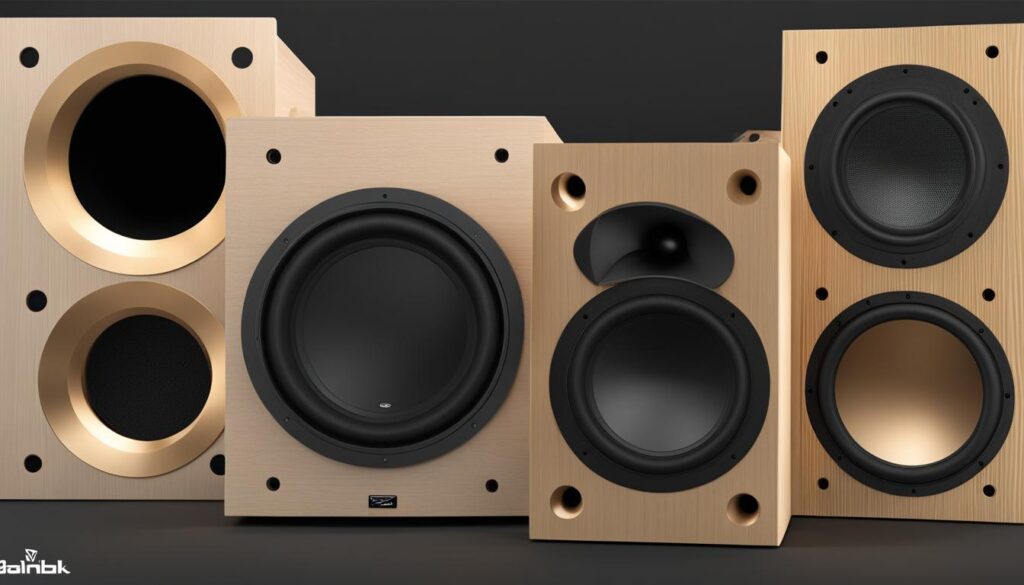
Understanding the pros and cons of each enclosure type will help you make an informed decision when building your subwoofer box. Choose the type that best suits your needs and preferences, and enjoy optimal bass performance in your audio system.
Conclusion
Building a custom subwoofer box for your 15-inch subwoofer is an exciting DIY project that allows you to personalize the design and fit while saving money. By following the step-by-step instructions and considering the different enclosure types, you can create a box that perfectly suits your needs. It is crucial to select the right subwoofer and carefully plan the dimensions of the box to achieve optimal performance.
Whether you opt for an infinite baffle, sealed enclosure, or ported enclosure, each has its own set of advantages and considerations. The infinite baffle provides an overall sound quality without the need for an enclosure, offering simplicity and space-saving. The sealed enclosure delivers accurate and tight bass reproduction, making it suitable for various music genres. On the other hand, the ported enclosure provides louder and more powerful bass, while requiring more tuning and space.
When building your custom subwoofer box, keep in mind some essential tips. Use quality materials like 3/4″ MDF, and reinforce the box if necessary. Ensure a sturdy assembly with screws and carpenter’s glue. Seal any gaps with silicon caulk to prevent air leaks and optimize performance. By investing time and effort in creating a custom subwoofer box, you can enjoy a superior audio experience with enhanced bass tailored to your preferences.
FAQ
How much does it cost to build a subwoofer box?
The cost of materials for building a subwoofer box is around $50, but it may vary depending on what you already have on hand.
How long does it take to build a subwoofer box?
The time it takes to build a subwoofer box typically takes about three hours, but it can vary depending on the complexity of the box’s shape and the tools available to you.
What should I consider when choosing a subwoofer for my box?
When choosing a subwoofer for your box, it’s important to consider the manufacturer’s recommended enclosure size and volume, as well as the available space in your vehicle.
How do I plan the dimensions of my subwoofer box?
To plan the dimensions of your subwoofer box, you need to determine the minimum depth, height, and width based on the size of your subwoofer and the available space in your vehicle. It’s also important to consider the internal dimensions of the box and calculate the internal box volume.
What tools and materials do I need to build a subwoofer box?
To build a subwoofer box, you will need a jigsaw, table saw or circular saw, electric drill, 3/4″ MDF, screws, carpenter’s glue, silicon caulk, and a speaker terminal cup.
What are the different types of enclosures for subwoofers?
The different types of enclosures for subwoofers are infinite baffle, sealed enclosure, and ported enclosure.
What are the pros and cons of each enclosure type?
The pros of an infinite baffle enclosure are easy construction and smooth frequency response, but it has limited power handling and output. A sealed enclosure offers accurate bass reproduction and good power handling, but it requires a larger size for deep bass. A ported enclosure provides increased output and good cone control but has a larger size and more group delay.
Why should I build a custom subwoofer box?
Building a custom subwoofer box allows you to customize the look and fit of your subwoofer while saving costs. It also allows you to tailor the box to your specific needs and preferences.






